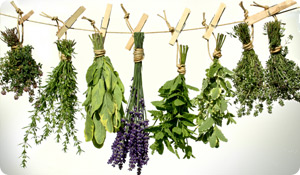
Herbs and spices are as at-home in your medicine chest as they are in your pantry. That's because they possess powerful healing properties that have been used as medicinals for thousands of years. Check out these 10 common herbs you may already have growing in your yard or sitting in your spice rack.
Lavender was historically used an antiseptic and also to boost mental health. Today, it has many purposes, such as helping with anxiety, insomnia, headaches, depression, and hair loss. Lavender flowers are commonly used in sachets and pillows, and lavender essential oils are popular in the field of aromatherapy. Lavender can also be combined with other oils for use in hair products.
Aloe Vera is used to treat wounds, skin conditions, burns, sunburns, stomach conditions and more. Aloe vera gel is found in hundreds of lotions, sun blocks, and skin products and can be taken orally.
Echinacea (AKA Coneflower) is used to treat or prevent colds, flu and other infections, to boost the immune system, and to treat skin problems. The plant and roots are used fresh or dried for teas and juice and also sold in supplements over the counter.
Evening Primrose Oil is used for eczema, arthritis, and women's health issues such as premenstrual breast pain, menopausal symptoms, and premenstrual syndrome. The oil is extracted from the seeds of the evening primrose flower and used in capsules.
Garlic is used to treat high blood pressure, high cholesterol, and heart disease and also to boost the immune system. It can be used fresh, dried, or in capsule form and is commonly added to food.
Ginger is used to treat stomach and intestinal ailments including nausea, diarrhea, and indigestion. It's also used to relieve morning sickness in pregnant women. It can be used fresh, dried or brewed in tea.
Peppermint is used to treat nausea, indigestion, cold and flu symptoms, headaches, muscle and nerve pain, and stomach and bowel conditions. It can be brewed into tea, chopped into food, or taken in capsule form.
Sage is used to treat mouth and throat inflammation, indigestion and other gastrointestinal problems, to reduce excessive sweating, and to improve mood and memory function. In some cultures, burning sage is used for spiritual purposes. It is available as dried leaves, liquid extracts, and sprays, and essential oils.
Turmeric can be applied directly to the skin for eczema and wound healing or taken orally to improve digestion, relieve arthritis pain, and regulate menstruation. It is also used for heartburn, stomach ulcers, and gallstones and to reduce inflammation. The stems of the turmeric plan are dried and used in a powder form in capsules, teas, or liquid extracts or used as a paste for the skin.
Green tea is used to prevent and treat several cancers (breast, stomach, and skin) and to improve mental function, increase weight loss, lower cholesterol, and increase immune function. Green tea is a popular beverage and can be served hot or cold.
While none of these herbs are intended to replace modern medicine, all of them can be used in appropriate ways to boost your health and wellbeing. Talk to your physician and a natural health specialist about which herbs are appropriate for you, and in what amounts.
Sources
National Institutes of Health
National Center for Complementary and Alternative Medicine
Herbs at a glance
http://nccam.nih.gov/health/herbsataglance.htm





